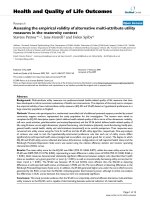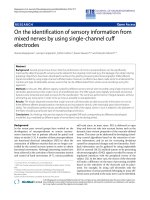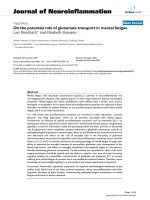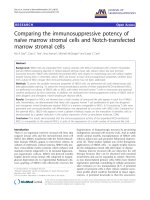Báo cáo hóa học: " On the EVM computation of arbitrary clipped multi-carrier signals" docx
Bạn đang xem bản rút gọn của tài liệu. Xem và tải ngay bản đầy đủ của tài liệu tại đây (390.45 KB, 7 trang )
RESEARCH Open Access
On the EVM computation of arbitrary clipped
multi-carrier signals
Igal Kotzer
*
and Simon Litsyn
Abstract
A common figure of merit in multi-carrier systems is the error vector magnitude (EVM). A method for EVM
computation of a multi-carrier signal without any underlying model (e.g., the Gaussianity assumption) was
proposed in a previous work of the authors. However, it addressed only the case of identical constellations and
power loadings in all tones. In practice, however, the constellation and power loading may vary among the tones
(e.g., boosted pilots, waterfilling and zero guard bands). Here the earlier approach is generalized in such a way that
it is able to accommodate for an accurate analytical EVM computation in the cases of power loading and different
constellations for different tones. Moreover, the derivation is valid for a general magnitude clipping functio n, so
that any realistic clipper can be plugged in.
1 Introduction
The use of multi-carrier (MC) communication schemes
(e.g., OFDM, DMT, etc.) is very common nowadays due to
its ability to cope well with channel interference while
keeping the receiver complexity low, the ease of spectral
mask shapi ng and high spectral ef fici ency. However, on e
of MC scheme’s greatest drawbacks is the high peak-to-
average power ratio (PAPR) caused by various degre es o f
coherent summation in the signal generati on using IFFT
[1]. Thus, systems utilizing MC communications must
work with a large back-off in the high-power amplifier
(HPA), which reduces both the efficiency of the HPA and
the average power transmitted, or risk clipping. Based on
the understanding that clipping is a nonlinear operation
causing both in-band and out-of-band spectral noise and
thus is an undesirable operation, methods for reducing the
PAPR were devised. For a survey see [1-4]. Most of the
power reduction methods are either statistical in nature–
that is they do not guaran tee PAPR limits, or iterative–in
which required PAPR limits are easier to meet at the
expense of computational complexity. Hence, while it is
understood that the amount of clipping should be mini-
mized, due to practical system limitations clipping cannot
be entirely eliminated, but rather be set on a compromise
level. Therefore, evaluating the performance of MC sys-
tems with clipping becomes relevant.
Two prominent criteria for evaluating the perfor-
manceofaMCsystemareitscapacity[5-7],andthe
system’s error probability [8,9]. However, in engineering
practice, the mo st popular measure is the error vector
magnitude (EVM). The EVM is a figure of merit for in-
band distortion, which does not only quantifies the dis-
tortion but in some cases can attribute impairments to
various system component s [10]. Due to its popularity
and troubleshooting capabilities, the EVM has become a
mandatory part of a few communication standards, e.g.
[[11], Tables 165, 172].
In [12] the authors express the EVM of an OFDM signal
impaired by clipping without relying on the Gaussianity
assumption and show that the EVM can be expressed with
an arbitrary precision as a power series of the number of
tones with constellation-dependent coefficients. It is also
shown that for some specific constellations the EVM can
be calculated via easy to use expressions without the need
for a power series expansion. However, these computa-
tions fit the case of MC signals with an identical constella-
tion for all tones and no power loading. Yet, real world
signal utilize both different constel lations for different
tones and power loading. Some o f the to nes are zeroed
due to spectral mask considerations, while some tones are
boosted (e.g., pilot tones) to allow better channel tracking.
A waterfilling solution in high SNR MIMO OFDM or in
DMT also requires adjusting power and thus constellation
to each tone individually. In this paper we address the
issue of various constellations and power loading in the
* Correspondence:
School of Electrical Engineering - Systems, Tel Aviv University, Israel
Kotzer and Litsyn EURASIP Journal on Advances in Signal Processing 2011, 2011:36
/>© 2011 Kotzer and Litsyn; licensee Springer. This is an Open Access article distributed under the terms of the Creative Commons
Attribution License ( licenses/by/2.0), which permits unrestricted use, distribution, and reproduction in
any medium, provided the original work i s properly cited.
MC signal as well as the effect of an arbitrary magnitude
clipping response by giving an analytical expression in the
form of a power series for computing the EVM of the gen-
eralized cas e.
Analysis of clipped signals usually relies on the Gaus-
sianity assumption [5]. However, this assumption is not
always valid, especially for a mix of BPSK and QAM
constellations. Hence, in order to evaluate the perfor-
mance of such systems one must resort to numerical
evaluations. This work allows to accurately compute the
EVM of clipped signals for any constellation mixture
and clipping function without the need to redo the
numerical evaluation for each desired scenario.
The paper is organized as follows. In Section 2 the
system model used in this work is introduced. Theorem
3.1 in Section 3 presents the main result of this work.
In Section 4 we present simulation results and compare
them to the theoretical results about EVM derived in
this work.
2 System model
The system model discussed in this work is depicted in
Figure 1. The vector a =[a
0
, a
1
, , a
N-1
]
T
denotes the N
data symbols vector in the form of constellation po ints,
e.g., a Î {+1, -1}
N
for BPSK. The vector x =[x
0
, x
1
, ,
x
N-1
]
T
denotes the time domain discrete time signal and
is obtained by applying the inverse discrete Fourier
transform on a:
x
n
=
1
√
N
N−1
k
=
0
a
k
e
i2πkn
N
,0≤ n ≤ N − 1
.
(1)
The vector y denotes the vector x after clipping opera-
tion. Two clipping function s we will specifically address
are the SSPA clipper [13]:
y
n
=
x
n
1+
|x
n
|
c
2p
1/2p
,
(2)
and the soft clipper (which is a special case of the
SSPA clipper for p ≫ 1):
y
n
=
x
n
|x
n
| < c
ce
ix
n
|x
n
|≥c
,
(3)
where c is the clipping level. The noise vector w
denot es an AWGN with variance
σ
2
w
and is independent
of a.
ˆ
x
is the noisy clipped discrete time domain signal
and
ˆ
a
is the d ata symbols vector reconstructed from t he
clipped and noisy signal. For this system we define the
EVM as
EVM
E{|
ˆ
a −a|
2
}
N · E{|a
k
|
2
}
.
(4)
Assuming the constellation energy
E
{|
a
k
|
2
}
is known
and the noise variance is known, we need to calculate
the error power
E
{|
ˆ
a −a
|
2
}
to be able to evaluate the
EVM. By virtue of Parseval’s theorem, we have
N−1
n=0
|x
n
|
2
=
N−1
k
=
0
|a
k
|
2
.
(5)
Hence, it immediately follows that
E{|
ˆ
a − a|
2
} = E{|
ˆ
x − x|
2
} =
N−1
n
=
0
E{|y
n
− x
n
|
2
} + Nσ
2
w
.
(6)
The EVM contribution due to clipping can thus be
calculated by computing the quantity
E{|
y
n
− x
n
|
2
}
for
every 0 ≤ n ≤ N - 1. Obviously, for scenaria with large
channel noise we can allow more signal distortion due
to clipping as long as it is negligible relative to the chan-
nel noise.
3 EVM computation
In this section we present the main result. Let f(|x
n
|) = f
( r) be the energy of the clipped portion of the sample
x
n
, and let us decompose the symbols vector a of leng th
N into three groups:
• N
B
groups of BPSK symbols. The symbols of each
group, of size N
r
, are drawn from a constellation
with energy
E
r
= b
2
r
for 1 ≤ r ≤ N
B
.
• N
Q
groups of QAM symbols. The symbols of e ach
group, of size N
s
, are drawn from a constellation of
size Ms, with constellation coefficients ν
s,lm
(which
are the series expansion coefficients of a function of
the constellation -see Appendix A for details.) and
energy
E
s
= q
2
s
for 1 ≤ s ≤ N
Q
. For example, for
QPSK of the form
a
k
R
,
a
k
I
∈ (±1/
√
2)
we have ν
s,11
= -1/4, ν
s,22
= -1/64, and for 16QAM of the form
a
k
I
∈ (±1, ±3)/
√
10
,
a
k
I
∈ (±1, ±3)/
√
10
we have
ν
s,11
= -1/4 and ν
s,22
= -17/1600.
• N
Z
zero tones.
Clearly N
B
+ N
Q
+ N
Z
= N. Then, the follow ing quan-
tities are defined:
μ
1
=
⎡
⎣
N
Q
s=1
q
2
s
N
s
ν
s,11
N
−
N
B
r=1
b
2
r
N
r
4N
⎤
⎦
(7)
IFFT FFT
Clipping Function
y
ˆ
a
x
a
w
ˆx
Figure 1 Baseband discrete time AWGN channel model.
Kotzer and Litsyn EURASIP Journal on Advances in Signal Processing 2011, 2011:36
/>Page 2 of 7
and
μ
2
=
⎡
⎣
N
Q
s=1
q
4
s
N
s
ν
s,22
N
2
−
N
B
r=1
b
4
r
N
r
32N
2
⎤
⎦
.
(8)
In addition, let
˜
μ
1
= N
μ
1
and
˜
μ
2
= N
2
μ
2
.
Theorem 3.1. The term
N−1
n
=
0
E{|y
n
− x
n
|
2
}
in (6) can
be calculated as follows:
N−1
n=0
E{|y
n
− x
n
|
2
} = N
2
∞
q
=0
m
q
(c)N
q
,
(9)
where m
q
(c) depend on the clipping level, the constella-
tions, power loading and symbol length. In particular, m
0
(c)and m
1
(c) can be calculated as follows:
m
0
(c)=−
∞
0
rf (r) exp
r
2
4μ
1
1
2 ˜μ
1
+
˜μ
2
˜μ
3
1
dr
,
(10)
m
1
(c)=−
∞
0
rf (r) exp
r
2
4μ
1
˜μ
2
2 ˜μ
4
1
r
2
+
˜μ
2
32 ˜μ
5
1
r
4
dr
.
(11)
Proof. See Appendix A. □
4 Simulation results and discussion
4.1 The Gaussian approximation
A common method for analyzing the EVM of an OFDM
sig nal uses the central l imit theorem (CLT). By invoking
the CLT x
n
are assumed to be distributed complex nor-
mally, i.e.
x
n
∼ CN
(
0, σ
2
)
,andthus|x
n
| ~ Rayleigh(s ).
Hence, the EVM can be computed in a straightforward
method:
N−1
n
=
0
E{|y
n
− x
n
|
2
} = N
∞
0
f (r)
r
σ
2
exp
−
r
2
2σ
2
dr
,
(12)
where f(r)=f(| x
n
|)is the clipping function in polar
coordinates. In this work, when the results are com-
pared to the Gaussian approximation it is assumed that
s
2
=1.
4.2 Simulation results
In the following examples two cases of magnitude clip-
ping functions are considered. The SSPA clipper, for
which
f (|x
n
|)=f (r)=
r
(
1+
(
r/c
)
2p
)
1/2p
− r
2
,
and the soft clipper, for which
f (|x
n
|)=f (r)=(r − c)
2
+
,
where the operation()
+
denotes taking only the positive
part. The soft clipper is a special case of the SSPA clipper
for p ® ∞, which can be practically achieved with p >
100. In the following simulations p =200waschosen.
Figure 2a demo nstrates the EVM versus clipping level for
the mixture of 64 BPSK modulated tones, 320 16QAM
modulated tones and 128 zero tones, all randomly spread
across the symbol. That is, N
B
=1,N
r =1
=64,N
Q
=1,
N
s =1
= 320, ν
1,11
=-1/4andν
1,22
= -17/1600. In this
figure all constellation energies are normalized to unity
(i.e. b
r
= q
s
= 1). Figure 2b demonstrates the EVM versus
clipping level for the mixture of 128 B PSK modulated
tones with constellation energy bo osted by 3 d B, 128
QPSK modulated tones and 256 16QAM modulated
tones (the two latter constellations are with unity constel-
lation energy). Namely, f or Figure 2b, the simulation
parameters are N
B
=1,N
r =1
= 128,
b
r
=
√
2
, and N
Q
=2
with N
s =1
=128,ν
1,11
= -1/4, ν
1,22
= -1/64, q
1
=1and
N
s =2
= 256, ν
2,11
= -1/4, ν
2,22
= -17/1600, q
2
=1.
It can be clearly seen that as the mixture becomes
more diverse in tone constellations and power loading,
the mixed signal’s EVM diverges from the Gaussian
model. Additionally, as can be expected, the less linear
the clipping function, the higher the EVM is. It can be
also seen that the analytical computation coincides per-
fectly with the simulation.
5 Summary
In this paper we present a method for computing the
EVM of a MC signal with power loading and various
conste llations on various tones that is impaired by clip-
ping. This computation does not rely on any underlyi ng
model for the signal (such as the Gaussianity assump-
tion), making it accurate for any mixture of tone con-
stellations and power l oading. A comparison between
the simulated and theoretical EVM resu lts shows a per-
fect match between the two. The main result of this
work can be also used with any arbitra ry magnitude
cli pping function for achieving more realistic results for
practical uses.
Appendix A Proof of the EVM computation
equation
We define the energy of the clipped portion of the sig-
nal as
f (x
n
)=f (x
n
R
, x
n
I
)=|y
n
− x
n
|
2
. Any clipping func-
tion can be represent ed as a superposition of its effect
on the signal’s magnitude (AM/AM) and its effect on
the signal’s phase (AM/PM). The AM/AM function can
be further represented in terms of |x
n
|. Thus, f can be
defined as
f (
x
n
2
R
+ x
n
2
I
)=f (r
)
,where
r =
x
n
2
R
+ x
n
2
I
is
the polar coordinates represe ntation. We wish to calcu-
late
E{f (x
n
R
+ x
n
I
)
}
any 0 ≤ n ≤ N -1. We start by repre-
senting
f
(
x
R
, x
I
)
by its inverse Fourier transform:
f (x
R
, x
I
)=
1
2π
∞
−
∞
f (ω
1
, ω
2
)e
i(ω
1
x
R
+ω
2
x
I
)
dω
1
dω
2
,
(13)
Kotzer and Litsyn EURASIP Journal on Advances in Signal Processing 2011, 2011:36
/>Page 3 of 7
where
ˆ
f
(
ω
1
, ω
2
)
is the Fourier transform of
f
(
x
R
, x
I
)
:
ˆ
f (ω
1
, ω
2
)=
1
2π
∞
−∞
f (x
R
, x
I
)e
−i(ω
1
x
R
+ω
2
x
I
)
dx
R
dx
I
=
∞
0
rf (r)
1
2π
2π
0
e
−ir(ω
1
cos(θ)+ω
2
sin(θ))
dθ d
r
(14)
=
∞
0
rf (r)J
0
r
ω
2
1
+ ω
2
2
dr
,
(15)
where J
0
is the Bessel function of the first kind and
zeroth order. Furthermore, x
n
can be written explicitly
as a sum of its real and imaginary parts as follows:
x
n
R
=
1
√
N
N−1
k=0
a
k
R
cos
2πkn
N
− a
k
I
sin
2πkn
N
,
x
n
I
=
1
√
N
N−1
k
=
0
a
k
R
sin
2πkn
N
+ a
k
I
cos
2πkn
N
.
(16)
Thus, we can substitute (16) into(13) and rewrite
f
(
x
R
, x
I
)
as
f (x
n
R
, x
n
I
)=
1
2π
∞
−∞
ˆ
f (ω
1
, ω
2
) exp
i
√
N
ω
1
N−1
k=0
a
k
R
cos
2πkn
N
− a
k
I
sin
2πkn
N
+ ω
2
N−1
k=0
a
k
R
sin
2πkn
N
+ a
k
I
cos
2πkn
N
dω
1
dω
2
=
1
2π
∞
−∞
ˆ
f (ω
1
, ω
2
) exp
i
√
N
N−1
k=0
a
k
R
ω
1
cos
2πkn
N
+ ω
2
sin
2πkn
N
+ a
k
I
−ω
1
sin
2πkn
N
+ ω
2
cos
2πkn
N
dω
1
dω
2
.
(17)
Denoting
φ
k
(α, β)=E
e
i(αa
k
R
+βa
k
I
,
(18)
and using the fact that a
k
are independent, we can
write:
E{f (x
n
R
, x
n
I
)} =
1
2π
(ω
1
,ω
2
)∈R
2
ˆ
f (ω
1
, ω
2
)
·
N−1
k
=
0
φ
k
ω
1
cos(
2πkn
N
)+ω
2
sin(
2πkn
N
)
√
N
,
−ω
1
sin(
2πkn
N
)+ω
2
cos(
2πkn
N
)
√
N
dω
1
dω
2
.
(19)
Therefore, according to(15)
E
{f (x
n
R
, x
n
I
)} =
1
2π
∞
0
rf (r)
(ω
1
,ω
2
)∈R
2
J
0
(r
ω
2
1
+ ω
2
2
)
·
N−1
k
=
0
φ
k
ω
1
cos(
2πkn
N
)+ω
2
sin(
2πkn
N
)
√
N
,
−ω
1
sin(
2πkn
N
)+ω
2
cos(
2πkn
N
)
√
N
dω
1
dω
2
dr
.
(20)
We now proceed to calculate the term
N−1
k
=
0
φ
k
of
(20) by expanding to a power series the term
N−1
k
=
0
ln φ
k
and then taking the exponent of the series.
Unlike [12], if a
k
are not identically distributed then j
k
must be computed for every k, or alternatively for every
type of constellation and then combined together. We
rewrite the arguments of j
k
as follows:
E{f (x
n
R
, x
n
I
)} =
1
2π
∞
0
rf (r )
(ω
1
,ω
2
)∈R
2
J
0
(r
ω
2
1
+ ω
2
2
)
N−
1
k=0
· φ
k
ζω
−kn
√
N
,
ζω
−kn
√
N
dω
1
dω
2
dr,
(21)
where ζ = ω
1
+ iω
2
,
¯
ζ
is the complex conjugate o f ζ
and ω = exp(2πi/N). Denoting
z
=
ζω
−
k
n
√
N
we can write j
k
as follows:
φ
k
(z)=φ
k
(z, z)=E exp {i(z · a
k
R
+ z ·a
k
I
)
}
(22)
(
b
)
(a)
1 1.5 2 2.5 3 3.5
−60
−50
−40
−30
−20
−10
0
10
c
EVM [dB]
Gaussian Approx., p=200
Mixed Theory, p=200
Mixed Sim., p=200
Gaussian Approx., p=3
Mixed Sim., p=3
Mixed Theory, p=3
1 1.5 2 2.5 3 3.5
−40
−30
−20
−10
0
10
c
EVM [dB]
Gaussian Approx., p=200
Mixed Theory, p=200
Mixed Sim., p=200
Gaussian Approx., p=3
Mixed Theory, p=3
Mixed Sim., p=3
Figure 2 Simulated and theoretical EVM versus clipping level
for two magnitude clipping functions. (a) Mixture of BPSK,
16QAM and zero tones. (b) Mixture of 3dB Boosted BPSK, QPSK and
16QAM tones.
Kotzer and Litsyn EURASIP Journal on Advances in Signal Processing 2011, 2011:36
/>Page 4 of 7
as in(18). We expand In j
k
as a power series:
ln φ
k
(z)=lnφ
k
ζω
−kn
√
N
=
l,m
≥
0
ν
(k)
lm
z
l
¯z
m
,
(23)
wherewechoosetherepresentation
φ
k
(z)=φ
k
(z, ¯z)=E exp {i((
z+¯z
2
)a
k
R
+(
z−¯z
2
i
)a
k
I
)
}
.We
further assume that the data symbols vector a contains
p ≤ N distinct groups of N
ι
,1 ≤ ι ≤ p symbols, where
each group is drawn from the set of BPSK, QAM or
zero constellation points with an average constellation
energy of E
ι
,1 ≤ ι ≤ p. That is, groups of symbols are
distinguished by the constellation type and by t he aver-
age constellation energy. Hence, we have
N−1
k=0
ln φ
k
ζω
−kn
√
N
=
N
1
−1
k=0
ln φ
1
ζω
−kn
√
N
+
N
2
−1
k=0
ln φ
2
ζω
−kn
√
N
+···+
N
p
−1
k=0
ln φ
p
ζω
−kn
√
N
.
(24)
Now we proceed to compute In j
k
for each type of
constellation:
• a
k
= 0:Thisoptionisusuallyusedtogenerate
guard bands [11]. For this option j
k
= 1, and hence
in j
k
=0.
• BPSK (a
k
=±b = b·{±1}): First, it is noted that a
k
are drawn from a BPSK constellation with energy
E
bpsk
= b
2
. Next, we compute in
ln φ
k
ζω
−kn
√
N
for a
group of 1 ≤ N
bpsk
≤ N bins. Now, using the fact
that a
k
are equi-probable we have
φ
k
(z)=
1
2
e
i
z+¯z
2
b
+
1
2
e
−i
z+¯z
2
b
=cos
b
z + ¯z
2
=cos
b
ζω
−
k
n
√
N
.
(25)
By Maclauren’s series expansion we have
ln(cos(θ)) =
∞
j
=1
ν
2j
(2j)!
θ
2j
,
(26)
where ν
2
= -1, ν
4
= -2, ν
6
= -16, etc. Now,
N
bpsk
−1
k=0
ln
cos
b
ζω
−kn
√
N
=
N
bpsk
−1
k=0
∞
j=1
ν
2j
(2j)!
b
1
√
N
ζω
−kn
2j
=
∞
j=1
ν
2j
(2j)!
1
2
√
N
2j
N
bpsk
−1
k=0
b
2j
(ζω
−kn
+
¯
ζω
kn
)
2j
=
∞
j=1
ν
2j
(2j)!
b
2
√
N
2j
N
bpsk
−1
k=0
⎡
⎣
2j
m=0
2j
m
(
¯
ζω
kn
)
2j−m
(ζω
−kn
)
m
⎤
⎦
=
∞
j
=1
ν
2j
(2j)!
b
2
√
N
2j
j
s=−
j
2j
j + s
ζ
j+s
¯
ζ
j−s
N
bpsk
−1
k=0
ω
−2kns
.
(27)
Using
N
bpsk
−1
k
=
0
ω
−2kns
=
N
bpsk
N|2ns (2ns is a multiple of N
)
0otherwise
,
(28)
(27) becomes
N
bpsk
−1
k=0
ln cos{···}=
∞
j=1
ν
2j
(2j)!
b
2
√
N
2j
j
s=−j
2j
j + s
ζ
j+s
¯
ζ
j−s
N
bpsk
−1
k=0
ω
−2kn
s
=
∞
j
=1
ν
2j
(2j)!
b
2
√
N
2j
N
bpsk
j
s=−
j
2j
j + s
ζ
j+s
¯
ζ
j−s
,
(29)
where N|2ns,-j ≤ s ≤ j and n Î [0, , N -1]. Next we
compute the first two terms of (29), that is for j =1,2,
as it is assumed these terms yield sufficient accuracy.
The cases of
n =0,
N
4
,
N
2
,
3N
4
require special attention.
However, as the impact of the slightly different analyti-
cal expression for the above four cases relative to all
other n is negligible for practical values of N (e.g., N ≥
128) these cases will be neglected and treated equally as
the rest of the BPSK tones.
-j = 1:Ifn ≠ 0, N/2 then the term
j
s=−j
2j
j + s
ζ
j+s
¯
ζ
j−
s
in (29) contains only the term
s =0,so
1
s
=−1
2
1+0
ζ
1+0
¯
ζ
1−0
=2|ζ |
2
.
(30)
-j = 2:Ifn ≠ 0, N/4, N/2,3N/4 then the only possible
term in the sum is s = 0, thus the sum is
2
s=−2
4
2+s
ζ
2+s
¯
ζ
2−s
=6|ζ |
4
.
(31)
Going back to (29)and substituting the above expres-
sions, we find the following:
N
bpsk
−1
k=0
ln cos{···}= N
bpsk
ν
2
2!
b
2
2
2
N
2|ζ |
2
+
ν
4
4!
b
4
2
4
N
2
6|ζ |
4
+ ···
= N
bpsk
−
b
2
|ζ |
2
4N
−
b
4
|ζ |
4
32N
2
−···
.
(32)
• M-QAM: The QAM constellation points are
drawn from the set
a
k
∈ q
(±1, ±3, , ±(
√
M − 1)) + i · (±1, ±3, , ±(
√
M − 1))
2
3
(M
2
− 1)
,
(33)
Kotzer and Litsyn EURASIP Journal on Advances in Signal Processing 2011, 2011:36
/>Page 5 of 7
i.e. the QAM constellation is symmetric and the con-
stellation energy is E
QAM
= q
2
. Symmetric QAM con-
stellations satisfy ν
00
=0,ν
20
= ν
02
=0,andν
11
<0. In
addition, in all the symmetric cases ν
lm
=0ifl+ m is
odd. We proceed by computing the expansion of
ln φ
k
ζω
−kn
√
N
for a group of 1 ≤ N
QAM
≤ N bins.
For the sake of simplicity, the expansion coefficients
ν
lm
here are for the unity energy constellation, hence
the expansion coefficients of in j are q
l+m
ν
lm
. For
example, for QPSK of the form
a
k
R
,
a
k
I
∈ (±1/
√
2)
we
have ν
11
= -1/4, ν
22
= -1/64, a nd for 16QAM of the
form
a
k
R
,
a
k
I
∈ (±1, ±3)/
√
10
we have ν
11
=-1/4and
ν
22
= -17/1600.
Then, similar to the BPSK case, we have
N
QAM
−1
k=0
ln φ
k
ζω
−kn
√
N
=
l,m≥0
ν
lm
q
l+m
N
l+m
2
ζ
l
¯
ζ
m
N
QAM
−1
k=0
ω
−kn(l−m)
= N
QAM
l,m:N|n(l−m)
ν
lm
q
l+m
N
l+m
2
ζ
l
¯
ζ
m
= N
QAM
q
2
ν
11
|ζ |
2
N
+
q
4
N
2
{ν
22
|ζ |
4
+ ν
31
ζ
3
¯
ζ + ν
13
ζ
¯
ζ
3
} + ···
.
(34)
We next decompose the symbols vector a of length N
into three groups:
• N
B
groups of BPSK symbols. The symbols of each
group, of size N
r
, are drawn from a constellation of
energy
E
r
= b
2
r
for 1 ≤ r ≤ N
B
.
• N
Q
groups of QAM symbols. The symbols of e ach
group, of size N
s
, are drawn from a constellation of
size M
s
(that is, the coefficients ν
lm
are constellation
dependent and are denoted as ν
s,lm
)and ener gy
E
s
= q
2
s
for 1 ≤ s ≤ N
Q
.
• N
Z
zero tones.
Obviously, N
B
+ N
Q
+ N
Z
= N.
Following(24),the expansions of In j
k
of all groups are
summed:
N−1
k=0
ln φ
k
ζω
−kn
√
N
=
N
B
r=1
−
b
2
r
N
r
|ζ |
2
4N
−
b
4
r
N
r
|ζ |
4
32N
2
−···
+
N
Q
s=1
q
2
s
N
s
ν
s,11
|ζ |
2
N
+
q
4
s
N
s
N
2
{ν
s,22
|ζ |
4
+ ν
s,31
ζ
3
¯
ζ + ν
s,13
ζ
¯
ζ
3
} + ···
=
⎡
⎣
N
Q
s=1
q
2
s
N
s
ν
s,11
N
−
N
B
r=1
b
2
r
N
r
4N
⎤
⎦
|ζ |
2
+
⎡
⎣
N
Q
s=1
q
4
s
N
s
ν
s,22
N
2
−
N
B
r=1
b
4
r
N
r
32N
2
⎤
⎦
|ζ |
4
+
N
Q
s
=1
q
4
s
N
s
N
2
[ν
s,31
ζ
3
¯
ζ + ν
s,13
ζ
¯
ζ
3
]+···
(35)
Denoting
μ
1
=
N
Q
s=1
q
2
s
N
s
ν
s
,11
N
−
N
B
r=1
b
2
r
N
r
4N
and
μ
2
=
N
Q
s=1
q
4
s
N
s
ν
s,22
N
2
−
N
B
r=1
b
4
r
N
r
32N
2
we have
N−1
k=0
φ
k
(N
−1/2
ζω
−kn
) = exp
⎧
⎨
⎩
μ
1
|ζ
2
| + μ
2
|ζ
4
| +
N
Q
s=1
q
4
s
N
s
N
2
[ν
s,31
ζ
3
¯
ζ + ν
s,13
ζ
¯
ζ
3
]+···
⎫
⎬
⎭
= exp{μ
1
|ζ |
2
}exp
⎧
⎨
⎩
μ
2
|ζ |
4
+
N
Q
s=1
q
4
s
N
s
N
2
[ν
s,31
ζ
3
¯
ζ + ν
s,13
ζ
¯
ζ
3
]+···
⎫
⎬
⎭
.
(36)
Now, using e
x
=1+x + we have
N−1
k=0
φ
k
(N
−1/2
ζω
−kn
) = exp{μ
1
|ζ |
2
}·
⎡
⎣
1+μ
2
|ζ |
4
+
N
Q
s=1
q
4
s
N
s
N
2
[ν
s,31
ζ
3
¯
ζ + ν
s,13
ζ
¯
ζ
3
]+···
⎤
⎦
.
(37)
Following (20), we multiply (37) by
1
2
π
J
0
(r|ζ |
)
and
integrate over ℝ
2
. First, we pass to polar coordinates u,θ
(i.e. ζ = u exp (iθ)), and observe that all the terms
ζ
l
¯
ζ
m
with l ≠ m vanish (since the integral of cos ((l-m)θ)is
zero). Therefore, we are left with
∞
0
J
0
(ru) exp{μ
1
u
2
}{u + μ
2
u
5
+ ···}du
.
(38)
Using [14,(6.631)] we arrive at
∞
0
J
0
(ru) exp{μ
1
u
2
}[u + μ
2
u
5
]du = −
1
2μ
1
1
F
1
1, 1,
r
2
4μ
1
−
μ
2
μ
3
1
1
F
1
3, 1,
r
2
4μ
1
.
(39)
Using the identities
1
F
1
(
1, 1, z
)
= e
z
and
1
F
1
(
3, 1, z
)
= e
z
(
1+2z + z
2
/2
)
and summing up N times
(20), we get
N−1
n
=
0
E{f (x
n
R
x
n1
)} = N
∞
0
rf (r) exp
r
2
4μ
1
−
1
2μ
1
−
μ
2
μ
3
1
(1 +
r
2
2μ
1
+
r
4
32μ
2
1
) −···
dr
.
(40)
Denoting
˜
μ
1
= N
μ
1
and
˜
μ
2
= N
2
μ
2
, (40) can be
rewritten as
N−1
n=0
E{f (x
n
R
x
n
I
)} =N
2
−
∞
0
rf (r) exp
r
2
4μ
1
1
2 ˜μ
1
+
˜μ
2
˜μ
3
1
dr
+ N
−
∞
0
rf (r) exp
r
2
4μ
1
˜μ
2
2 ˜μ
4
1
r
2
+
˜μ
2
32 ˜μ
5
1
r
4
dr
+ ···
,
(41)
and following (9) we have
m
0
(c)=−
∞
0
rf (r) exp
r
2
4μ
1
1
2 ˜μ
1
+
˜μ
2
˜μ
3
1
d
r
(42)
and
m
1
(c)=−
∞
0
rf (r) exp
r
2
4μ
1
˜μ
2
2 ˜μ
4
1
r
2
+
˜μ
2
32 ˜μ
5
1
r
4
dr
.
(43)
Abbreviations
CLT: central limit theorem; EVM: error vector magnitude; HPA: high-power
amplifier; MC: multi-carrier; PAPR: peak-to-average power ratio.
Acknowledgement
The authors would like to thank Eyal Verbin for his contribution to this work.
Competing interests
The authors declare that they have no competing interests.
Received: 27 November 2010 Accepted: 8 August 2011
Published: 8 August 2011
References
1. S Litsyn, Peak Power Control in Multicarrier Communications (Cambridge
University Press, Cambridge, 2007)
Kotzer and Litsyn EURASIP Journal on Advances in Signal Processing 2011, 2011:36
/>Page 6 of 7
2. SH Han, JH Lee, An overview of peak-to-average power ratio reduction
techniques for multicarrier transmission. IEEE Wireless Commun Mag. 12,
56–65 (2005). doi:10.1109/MWC.2005.1421929
3. T Jiang, Y Wu, An overview: peak-to-average power ratio reduction
techniques for OFDM signals. IEEE Trans Broadcast. 54(2), 257–268 (2008)
4. J Tellado, Multicarrier Modulation with Low PAR (Kluwer Academic
Publishers, Dordrecht, 2000)
5. H Ochiai, H Imai, Performance analysis of deliberately clipped ofdm signals.
IEEE Trans Commun. 50(1), 89–101 (2002). doi:10.1109/26.975762
6. F Peng, WE Ryan, On the capacity of clipped ofdm channels, in ISIT2006,
Seattle, USA, 9-14 July 2006 (2006)
7. R Raich, H Qian, G Zhou, Optimization of SNDR for amplitude-limited
nonlinearities. IEEE Trans Commun. 53(11), 1964–1972 (2005). doi:10.1109/
TCOMM.2005.857141
8. A Bahai, M Singh, A Goldsmith, B Saltzberg, A new approach for evaluating
clipping distortion in multicarrier systems. IEEE J Sel Areas Commun. 20(5),
1037–1046 (2002). doi:10.1109/JSAC.2002.1007384
9. H Nikopour, S Jamali, On the performance of OFDM systems over a
Cartesian clipping channel: a theoretical approach. IEEE Trans Wireless
Commun. 3(6), 2083–2096 (2004). doi:10.1109/TWC.2004.837425
10. B Cutler, Effects of physical layer impairments on ofdm systems. RF Design,
36–44 (May 2002)
11. IEEE standard for local and metropolitan area networks, part 16: Air
interface for fixed broadband wireless access systems, IEEE, Technical Report
(2004)
12. I Kotzer, S Har-Nevo, S Sodin, S Litsyn, An analytical approach to the
calculation of EVM in clipped multi-carrier signals (in press)
13. C Rapp, Effects of hpa-nonlinearity on a 4-dpsk/ofdm-signal for a digital
sound broadcasting system. in Second European Conference on Satellite
Communications, 22-24.10.91, Liege, Belgium, 179–184 (1991)
14. I Gradshteyn, I Ryzhik, Table of Integrals, Series and Products (Elsevier,
Amsterdam, 2007)
doi:10.1186/1687-6180-2011-36
Cite this article as: Kotzer and Litsyn: On the EVM computation of
arbitrary clipped multi-carrier signals. EURASIP Journal on Advances in
Signal Processing 2011 2011:36.
Submit your manuscript to a
journal and benefi t from:
7 Convenient online submission
7 Rigorous peer review
7 Immediate publication on acceptance
7 Open access: articles freely available online
7 High visibility within the fi eld
7 Retaining the copyright to your article
Submit your next manuscript at 7 springeropen.com
Kotzer and Litsyn EURASIP Journal on Advances in Signal Processing 2011, 2011:36
/>Page 7 of 7









